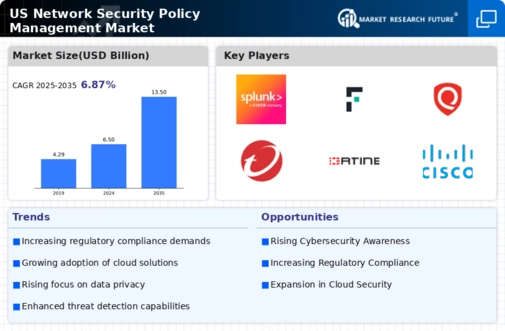The network security-policy-management market is characterized by a dynamic competitive landscape, driven by the increasing demand for robust cybersecurity solutions amid rising cyber threats. Key players such as Palo Alto Networks (US), Cisco Systems (US), and Fortinet (US) are at the forefront, each adopting distinct strategies to enhance their market positioning. Palo Alto Networks (US) emphasizes innovation through continuous product development, focusing on AI-driven security solutions. Cisco Systems (US) leverages its extensive networking expertise to integrate security into its broader IT offerings, while Fortinet (US) aims for aggressive market penetration through competitive pricing and comprehensive security solutions. Collectively, these strategies contribute to a competitive environment that is both concentrated and fragmented, with significant influence from established players and emerging startups alike.
In terms of business tactics, companies are increasingly localizing their operations to better serve regional markets and optimize supply chains. The market structure appears moderately fragmented, with a mix of large enterprises and smaller niche players. This fragmentation allows for diverse offerings, catering to various customer needs, while the presence of major players ensures a competitive atmosphere that drives innovation and service quality.
In October 2025, Palo Alto Networks (US) announced a strategic partnership with a leading cloud service provider to enhance its cloud security offerings. This collaboration is poised to strengthen Palo Alto's position in the cloud security segment, enabling it to provide integrated solutions that address the complexities of multi-cloud environments. Such partnerships are crucial as organizations increasingly migrate to cloud infrastructures, necessitating advanced security measures.
In September 2025, Cisco Systems (US) launched a new suite of security products designed to protect against advanced persistent threats (APTs). This initiative reflects Cisco's commitment to innovation and its strategy to remain competitive in a rapidly evolving threat landscape. By focusing on APTs, Cisco aims to address the growing concerns of enterprises regarding sophisticated cyber attacks, thereby reinforcing its market presence.
In August 2025, Fortinet (US) expanded its global reach by acquiring a regional cybersecurity firm, enhancing its capabilities in threat intelligence and incident response. This acquisition not only broadens Fortinet's service offerings but also positions it to better compete against larger rivals by leveraging localized expertise. Such strategic moves indicate a trend towards consolidation in the market, as companies seek to enhance their competitive edge through acquisitions.
As of November 2025, the competitive trends in the network security-policy-management market are increasingly defined by digitalization, AI integration, and a focus on sustainability. Strategic alliances are becoming more prevalent, as companies recognize the need for collaborative approaches to tackle complex cybersecurity challenges. Looking ahead, competitive differentiation is likely to evolve, shifting from price-based competition to a focus on innovation, technological advancements, and supply chain reliability. This transition underscores the importance of agility and responsiveness in a market that is continuously adapting to new threats and opportunities.
























Leave a Comment